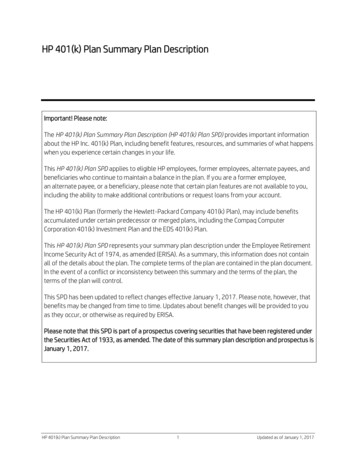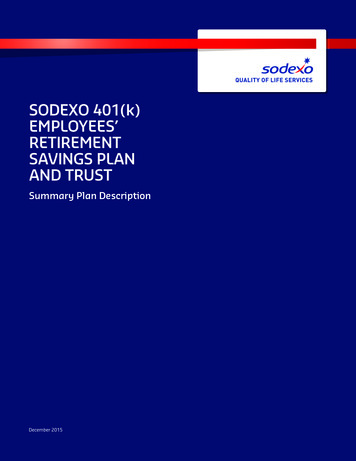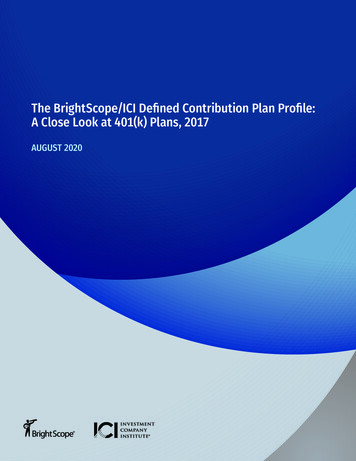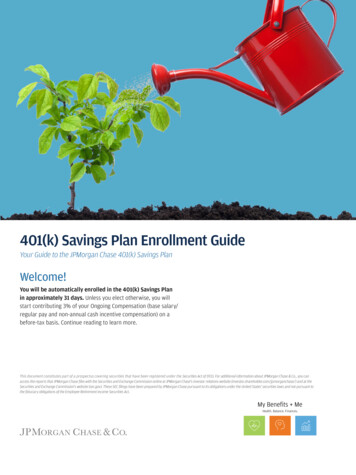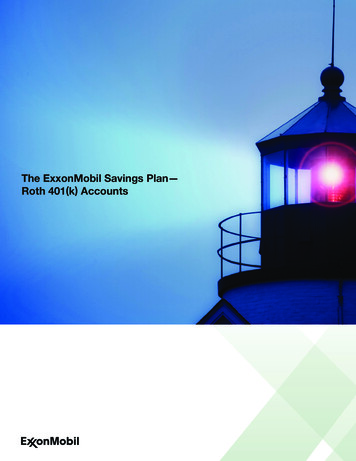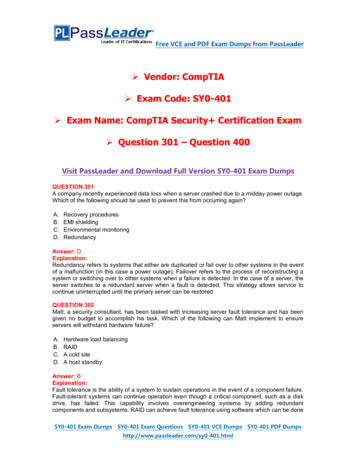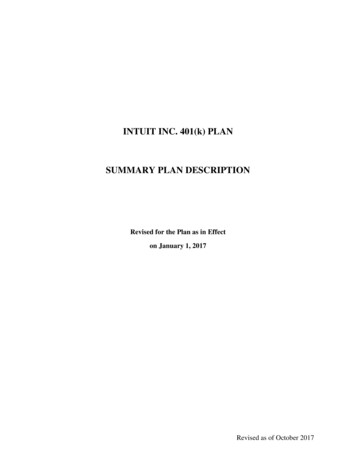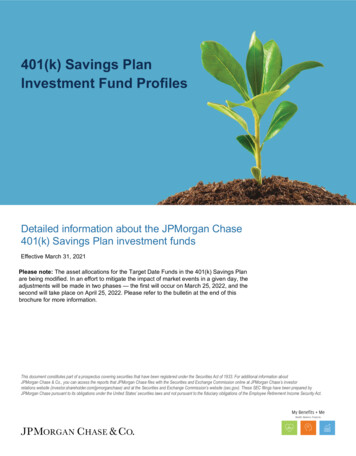
Transcription
401(k) Savings PlanInvestment Fund ProfilesDetailed information about the JPMorgan Chase401(k) Savings Plan investment fundsEffective March 31, 2021Please note: The asset allocations for the Target Date Funds in the 401(k) Savings Planare being modified. In an effort to mitigate the impact of market events in a given day, theadjustments will be made in two phases — the first will occur on March 25, 2022, and thesecond will take place on April 25, 2022. Please refer to the bulletin at the end of thisbrochure for more information.This document constitutes part of a prospectus covering securities that have been registered under the Securities Act of 1933. For additional information aboutJPMorgan Chase & Co., you can access the reports that JPMorgan Chase files with the Securities and Exchange Commission online at JPMorgan Chase’s investorrelations website (investor.shareholder.com/jpmorganchase) and at the Securities and Exchange Commission’s website (sec.gov). These SEC filings have been prepared byJPMorgan Chase pursuant to its obligations under the United States’ securities laws and not pursuant to the fiduciary obligations of the Employee Retirement Income Security Act.Health. Balance. Finances.
The 401(k) Savings PlanWeb Center and Call CenterYou can use the 401(k) Savings Plan Web Center and Call Center to access Plan information and conduct certain Plantransactions. In addition, you can access fact sheets for each of the investment options in the Plan in the Investment lineupsection of the Web Center. The fact sheets include information such as comparisons to benchmarks, portfolio turnover rates, totalannualized returns over specific time periods and asset allocations, as well as the expense ratio for each investment option. Thefact sheets are regularly updated on a monthly basis.Also available on the 401(k) Savings Plan Web Center is the Participant Fee Disclosure Notice (please note that thisdocument is referred to as the Current Investment Returns & Fee Comparison notice on the Web Center). This notice is issuedannually and provides detailed information regarding investment performance and the fees and expenses charged underthese investment options.To access the 401(k) Savings Plan Web Center:You can access the 401(k) Savings Plan Web Center from work or from home via My Rewards: From work: My Rewards from the intranet From home: myrewards.jpmorganchase.comTo contact the 401(k) Savings Plan Call Center:Call 1-866-JPMC401k (1-866-576-2401), or 1-303-737-7204 if calling from outside the United States. (The TTY number is1-800-345-1833.) Client Service Representatives are available from 8 a.m. to 10 p.m. Eastern time, Monday through Friday,except New York Stock Exchange holidays.The JPMorgan Chase U.S. Benefits Program generally is available to most employees on a U.S. payroll who are regularly scheduled to work 20 hours or more aweek and who are employed by JPMorgan Chase & Co. or one of its subsidiaries to the extent that such subsidiary has adopted the JPMorgan Chase U.S. BenefitsProgram. This information does not include all of the details contained in the applicable insurance contracts, plan documents and trust agreements. If there is anydiscrepancy between this information and the governing documents, the governing documents will control. JPMorgan Chase & Co. expressly reserves the right toamend, modify, reduce, change or terminate its benefits and plans at any time. The JPMorgan Chase U.S. Benefits Program does not create a contract or guaranteeof employment between JPMorgan Chase and any individual. JPMorgan Chase or you may terminate the employment relationship at any time.1JPMorgan Chase 401(k) Savings Plan Investment Fund Profiles
Table of contentsSection 1: Understanding your choices and the decisions you need to make . 3Two ways to invest . 3How do you choose the right path for you? . 3Investing approach #1: Target Date Funds (“No Assembly Required”) . 4Investing approach #2: Core Funds (“Do It Yourself”) . 5Section 2: Back to basics . 7Knowing your risk tolerance . 7Understanding the importance of diversification. 8Section 3: Your investment choices . 9Important reminders . 9Additional resources . 9Target Date Funds . 11Core Funds . 19Section 4: Summary of investment risks . 46Section 5: Important investment terms . 50JPMorgan Chase 401(k) Savings Plan Investment Fund Profiles2
Section 1: Understanding your choicesand the decisions you need to makeAbout this brochureMaking sure you’re savingenough requires knowledgeand planning. That’s whyJPMorgan Chase providesyou with some of the toolsand resources you mayneed to help you buildyour investment portfolio.This brochure providesinformation to help youunderstand the investmentfund choices under the401(k) Savings Plan.The JPMorgan Chase 401(k) Savings Plan has thousands of participants — ranging from those whoare not as comfortable making investment decisions to those who enjoy taking a hands-on approach tomanaging their money. No matter what type of investor you are, the 401(k) Savings Plan provides you withthe opportunity to choose the investment strategy that’s right for you.Two ways to investWe know that making investment decisions can be overwhelming. That’s why the Plan offers two distinctways to invest — and you pick the investment strategy that’s right for you. Depending on your know-howand risk tolerance, you can choose the investment approach that meets your needs.In addition, investmentinformation and factsheets for all investmentoptions are provided on the401(k) Savings Plan WebCenter. The fact sheetsare regularly updated on amonthly basis.The Participant FeeDisclosure Notice is alsoavailable on the 401(k)Savings Plan Web Center.This notice is issuedannually and providesdetailed informationregarding investmentperformance and thefees and expensescharged under theseinvestment options.Please read thesematerials carefully.Target Date Funds(“No Assembly Required”)Core Funds(“Do It Yourself”)Target Date Funds offer you built-in diversificationwithin a single investment option — with noassembly required. These Funds provide amix of underlying investments and, with theexception of the Target Date Income Fund, thatmix automatically changes — becoming moreconservative over time — as the Fund movescloser to its “target” date.If you prefer to build your own portfolio, youcan choose any number of Core Funds toachieve diversification among several assetclasses. This strategy puts you in charge.When you choose among the Core Funds, youtake the responsibility for creating a diversifiedmix, monitoring it regularly and rebalancingas needed.How do you choose the right path for you?Before you get into the details of how your investment options work, you may want to take a few minutes tothink about what kind of investor you are. Let’s assume you are already saving for retirement in the 401(k)Savings Plan. (If you’re not, there’s no better time to start than today!)If you aren’t sure how to define yourself as an investor, you can get a good idea by answering a fewquestions. There are no right or wrong answers:1. Do I want to select my own mix of investment funds?2. Am I comfortable deciding how much to invest in each fund?3. Do I have time to track my investments and make changes as needed?The answers to these questions can help you align your choices with your preferences and goals. Forexample, if you answered mostly “yes” to these questions, you may want to consider using the CoreFunds. If you answered mostly “no,” the Target Date Funds may present an attractive option for you.3JPMorgan Chase 401(k) Savings Plan Investment Fund Profiles
Investing approach #1:A note about theTarget Date FundsTarget Date Funds (“No Assembly Required”)Because the underlyinginvestments within each ofthe Target Date Funds aregenerally passively managed,the investment managementfees are typically lower thanin actively managed funds.(The fees paid by participantsfor each Target Date Fund are3-5 basis points. For example,for a fund with a fee of 3 basispoints (0.03%), the annual feeon a 1,000 investment wouldbe about 0.30 annually.)Target Date Funds take a lot of the guesswork out of investment decision-making. Designed by investmentprofessionals within Asset Management Solutions – Multi-Asset Solutions (MAS) within JPMorgan ChaseBank, N.A., Target Date Funds provide a mix of investments across a range of asset classes, including somenot directly available in the Core Fund lineup, such as emerging markets debt and Real Estate InvestmentTrusts (REITs). When you invest in a Target Date Fund, you’re already diversified.To choose a Target Date Fund, estimate the date at which you think you will begin withdrawing money fromyour account (generally, when you intend to retire). Then, identify the Target Date Fund that most closelyaligns with the date you intend to retire (when making a decision, you should also take into account otherfactors, such as your goals and risk tolerance).Each Target Date Fund, with the exception of the Target Date Income Fund, has a date in its name thatcorresponds to an expected “target year.” With the exception of the Target Date Income Fund, the mix ofinvestments in the fund you choose automatically rebalances — becoming more conservative over time —as you move closer to your estimated “target year.” Please keep in mind that you should periodically reviewall of your investments, including your investment in the Target Date Funds, to make sure you’re not overlyconcentrated in a particular asset class.Target Date Funds with dates farthest in the future have the most aggressive investment mix. They start outinvesting largely in equities (stocks), but then gradually rebalance assets over time to include greater amountsof more conservative investments, such as bonds and cash alternatives. While funds with closer target datesstart out with a conservative investment mix, the mix progressively becomes even more conservative as thefund’s target year gets closer. However, all of the Target Date Funds, including the Target Date Income Fund,continue to invest in equities.As with all investments, the principal value of the fund(s) is not guaranteed at any time, including at thetarget date.RiskHigherHow a Target Date Fund changes over timeBond/Cash alternative fundsLowerStock fundsEarly yearsMiddle yearsThe charts, graphs and screen prints in thisdocument are for illustrative purposes only.Target years(When you’ll need the money)JPMorgan Chase 401(k) Savings Plan Investment Fund Profiles4
Investing approach #2:Core Funds (“Do It Yourself”)When you invest in the Core Funds, you build your portfolio and allocate your contributions across avariety of funds that fall under two basic asset classes: fixed-income (bonds and cash alternatives) andequity (stocks). In general, fixed-income funds offer the potential for lower risk of loss and lower returnsas compared to equity. Equity funds, on the other hand, offer the potential for high risk of loss with thepotential for a higher return as compared to fixed income. Diversifying within an asset class can also helpstrengthen your portfolio, so it’s important to understand the different types of investments in each of thebasic asset classes. Fixed-income funds. The 401(k) Savings Plan offers several fixed-income funds. As you reviewthem, you should consider their maturity and credit quality. The longer the maturity (or duration)of a fixed-income fund, the more sensitive it is to a change in interest rates. Its credit quality is ameasurement of the underlying bond issuers’ ability to repay the interest and principal. Generally, thehigher the bond’s credit rating, the lower the risk the issuer will default on its obligation to pay interestand principal. Equity funds. The 401(k) Savings Plan offers a wide range of equity funds, including theJPMorgan Chase Common Stock Fund. As you review your options, you should consider the marketcapitalization of the companies in which they invest. Market capitalization refers to a dollar value of acompany’s outstanding shares (determined by multiplying the number of shares by the current marketprice of one share). You should also consider the fund’s investment style or strategy and where thefund invests — domestically or internationally. All of these factor into the risk and return profiles ofthe funds.5JPMorgan Chase 401(k) Savings Plan Investment Fund Profiles
Fund profilescan helpCore Fund choices at a glanceRisk/returnlevelFund nameShort-term fixedincomeLowShort-Term Fixed Income FundStable valueLow to moderateStable Value FundInflation-ProtectedSecurities (IPS)Low to moderateGovernment Inflation-ProtectedBond FundIntermediate bondLow to moderateHigh-yield bondModerateto highHigh Yield Bond FundHighLarge Cap Value Index FundHighLarge Cap Value FundHighS&P 500 Index FundHighLarge Cap Growth Index FundHighLarge Cap Growth FundHighS&P MidCap 400 Index FundHighSmall Cap Index FundHighSmall Cap Core FundHighSmall Cap Blend FundHighInternational Large CapValue FundHighInternational Large CapIndex FundInternationalsmall capHighInternational Small CapIndex FundEmerging marketequityEmerging marketequityHighEmerging Market EquityIndex FundCompany stockCompany stockHighJPMorgan Chase CommonStock FundAsset classCash alternativesBondsLarge capDomestic equityMid capSmall capInternationalequityInternationallarge capStarting on page 10 of thisbrochure, you will find fundprofiles for each of theinvestment fund options inthe 401(k) Savings Plan.In addition, investmentinformation and fact sheetsfor all available investmentoptions are available on the401(k) Savings Plan WebCenter. This informationprovides factors to considerwhen making your choices,such as the investmentstrategy and objectives,risks and fees.Core Bond FundIntermediate Bond FundThe Participant FeeDisclosure Notice is alsoavailable on the 401(k)Savings Plan Web Center.This notice is issuedannually and providesdetailed informationregarding investmentperformance and thefees and expenses chargedunder these investmentoptions.You should also review theprospectus for the CommonStock Fund.To receive aprospectus for theCommon StockFund:Passive and active investment optionsWithin the Core Fund lineup, you can choose from both active and passive equity investment options.You can distinguish the passive funds by looking for the word “Index” in the fund name.Call the 401(k) Savings PlanCall Center. Alternatively, youcan view the prospectus onlineat the 401(k) Savings PlanWeb Center. See page 1for contact information.For more information about actively managed and passively managed funds, please see page 9.JPMorgan Chase 401(k) Savings Plan Investment Fund Profiles6
Section 2: Back to basicsKeep your assetsaligned with yourinvestment strategyRebalancing meansadjusting the investmentsin your portfolio tothe intended mix ofstocks, bonds and cashalternatives. If youchoose to invest in theCore Funds, rebalancingyour investments is yourresponsibility. If you choosea Target Date Fund, theallocations are regularlymonitored and typicallyrebalanced monthly withthe goal of maintaining anappropriate mix.We encourage you to regularly review your investment strategy — making sure your investments are alignedwith your risk tolerance and that your assets are adequately diversified, taking into account your investmentsinside and outside of the 401(k) Savings Plan. You may wish to consult with a personal financial advisor, taxadvisor or other qualified financial professional before making decisions about your investments in the Plan.In the meantime, here is a quick refresher on some of the basics you should keep in mind as you review yourinvestment choices.Knowing your risk toleranceAs you decide how to invest your money, it’s important to be aware of your tolerance for risk of loss of allor part of your principal investment — that is, how much risk you’re willing to accept in your investments.Deciding how much risk you’re comfortable with depends on several factors: Your personality. Some people are naturally more conservative than others. You may want to askyourself: “Am I willing to accept the risk that my investments may not do well in the short term but havethe potential to provide high returns later on?” and “How likely is it that I can replace any money I lose?”Thinking about your answers can help guide your choices. Future financial resources. If you know you have other sources of income available when you retire,you might have the flexibility or willingness to take more risk with your 401(k) investments.You also need to understand different types of risk as you are looking at your investment options: Market risk. Economies and financial markets throughout the world are becoming increasinglyinterconnected, which increases the likelihood that events or conditions in one country or region willadversely impact markets or issuers in other countries or regions. Inflation risk. This is the likelihood the value of your investments will not keep up with inflation.Generally, inflation risk is lower in the short term, but it can have a greater impact over time.Most investments involve a trade-off between market risk and inflation risk. Very conservative investmentsprovide protection against market risk, but relatively little protection against the effect of inflation. Lessconservative investments provide greater protection against inflation risk, but are subject to more risk in thefinancial markets. For information about these investment risks and many other types of investment risk,please see Section 4, “Summary of investment risks.”7JPMorgan Chase 401(k) Savings Plan Investment Fund Profiles
Understanding the importance of diversificationWhile it’s entirely up to you to decide how to invest your 401(k) Savings Plan account, most investmentprofessionals agree that diversification is key to managing your risk of loss. Diversification — spreadingmoney across a broad range of investments — is a way to reduce your overall risk. Having a mix of stocks,bonds and cash alternatives in your portfolio may help even out the effect of market swings by cushioningthe impact of a drop in the value of any one security on your total account balance. Simply put, the highsof one investment can help offset the lows of another. The 401(k) Savings Plan offers a broad selection ofinvestment funds and asset classes, giving you the opportunity to manage volatility and risk.Only you can know how much risk allows you to meet your objectives without losing sleep. Before investing,it is critical to spend time considering your options — whether choosing a Target Date Fund or selectingamong the Core Funds. Read this Investment Fund Profiles brochure carefully and refer to the online fundmaterials regularly for updates to help you stay current with your investments.Diversification is keyThe following are some important reminders from the Department of Labor regarding individualinvesting and the importance of diversifying your investments. Please go to for additional information.To help achieve long-term retirement security, you should give careful consideration to the benefitsof a well-balanced and diversified investment portfolio. Spreading your assets among differenttypes of investments may help you achieve a favorable rate of return and minimize your overall riskof losing money. This is because market or other economic conditions that cause one category ofassets, or one particular security, to perform well often cause another asset category, or anotherparticular security, to perform poorly. If you invest more than 20% of your retirement savings in anyone company or industry, your savings may not be properly diversified. Although diversification is nota guarantee against loss, it may be an effective strategy to help you manage investment risk.JPMorgan Chase 401(k) Savings Plan Investment Fund Profiles8
Section 3: Your investment choicesInvest carefullyThe investment funds arenot deposits or obligationsof — nor guaranteed by —JPMorgan Chase & Co.,JPMorgan Chase Bank, N.A.or any of their subsidiaries.Nor are they insured by theFederal Deposit InsuranceCorporation (FDIC), theFederal Reserve Board orany other governmentalagency. Investments in thefunds involve risks, includingthe possible loss of principal.Therefore, it’s importantthat you make informedinvestment decisions onlyafter carefully readingall the Plan information(including the prospectus forthe Common Stock Fund,as well as the informationfound on the 401(k) SavingsPlan Web Center). Youmay also want to consult afinancial advisor, tax advisoror other qualified financialprofessional regarding aninvestment strategy that’sright for you.The following pages provide detailed descriptions of the Plan’s investment funds, including theirinvestment objectives, strategies and fees. See the “Additional resources” section below for additionalmaterials that are available online.Important remindersAs you review the fund profiles, it will be helpful to keep the following important points in mind: The Code of Conduct extends to all personal investing activities, including your transactionsin the JPMorgan Chase 401(k) Savings Plan. If applicable, your line of business may also haveadditional policies that apply to investing activities. To access the Code of Conduct, please visitCompany Home About Us Code of Conduct. Additional resourcesYou can go online to access detailed fund information — much of which is updated on at least aquarterly basis.If you need:Go to the 401(k) Savings Plan Web CenterCurrent performance and portfolio informationInvestment lineupRecent fee informationInvestment lineupProspectus for the Common Stock FundPlan forms 401k ProspectusTo receive free paper copies of these materials, please contact the 401(k) Savings Plan Call Center.See page 1 for contact information.9JPMorgan Chase 401(k) Savings Plan Investment Fund Profiles
Fund profilesTarget Date Funds .11Core Funds.19JPMorgan Chase 401(k) Savings Plan Investment Fund Profiles10
Target Date FundsInvestment typeThe Target Date Funds are lifecycle investment options comprisinga mix of underlying investment funds across a broad range ofasset classes.Investment objectiveWith the exception of the Target Date Income Fund, the remainingTarget Date Funds are broadly diversified portfolios that seektotal return as appropriate for the target date listed within the fundname (2025 through 2065). These Target Date Funds invest in amix of equity, fixed income, Real Estate Investment Trusts (REITs),Inflation-Protected Securities (IPS) and cash to a varying degreedepending on the appropriate risk level for the average investorexpecting to retire at each of the target dates. As the Target DateFund approaches its target date, the portfolio’s asset allocation willshift to a more conservative mix.The Target Date Income Fund asset allocation seeks current incomeand some capital appreciation. It invests in similar investmentsas the other Target Date Funds but with an intended risk levelappropriate for the average investor at or very near retirement, or aninvestor with a low risk tolerance.Investment strategyEach Target Date Fund is a “fund of funds” and attempts to achievethe stated objective by investing in underlying funds that make upits asset allocation. The asset allocation has been constructed andwill be maintained by Asset Management Solutions – Multi-AssetSolutions (MAS) within JPMorgan Chase Bank, N.A. Except as notedbelow, most of the underlying funds are index funds that attemptto replicate the associated index but will not necessarily have thesame performance as the index due to management and other fees,transaction costs, security selection and cash flows. The high-yieldbond, emerging markets debt and cash alternative components areactively managed. Allocations for the Target Date Funds are regularlymonitored and typically rebalanced monthly to the targeted assetallocation, with the goal of maintaining an optimal portfolio for thestated investment objectives.11Investment management feesFees are deducted from the investment performance of eachTarget Date Fund and are based on the investment allocations andthe investment management fees and administrative fees (if any)associated with each underlying fund. For example, if a Target DateFund has investment management and administrative fees of 3 basispoints (0.03%), the fee on a 1,000 investment would be about 0.30annually. These fees are referred to as the annual expense ratio ortotal annual operating expenses. Please refer to the Fund Facts on thefollowing pages for details on each fund’s expense ratio. Please note:The investment management and administrative fees may changeover time as the asset values and/or underlying investmentmix changes.In addition to the total annual operating expenses noted above, theTarget Date Funds will pay transaction costs, such as commissions,when the underlying funds buy or sell securities. These transactioncosts are also charged to the investment performance of each TargetDate Fund.The investment management fees associated with the maintenance ofthe glide path (the changing mix of stock, bonds and cash equivalentswithin each of the Target Date Funds) and for the emerging marketsdebt component of the Target Date Funds are not charged to theperformance of the Target Date Funds. These fees will be paid byJPMorgan Chase. For more information about the glide path, please seepage 18.Please note: These Funds may hold temporary investments to meetliquidity needs or to achieve the manager’s investment objectives.For more information, please see “Temporary investments” inSection 4.Fund holdingsAll of the index fund holdings are passively managed by BlackRockInstitutional Trust Company, N.A. or State Street Global AdvisorsTrust Company. The emerging markets debt, cash alternatives andhigh-yield bond funds are actively managed by JPMorgan ChaseBank, N.A., BlackRock Institutional Trust Company, N.A. andColumbia Threadneedle Investments, respectively.(continued)JPMorgan Chase 401(k) Savings Plan Investment Fund Profiles
401(k) Savings PlanInvestment points to considerThe offerings are managed as institutional separate accounts.The value of an investment in the Target Date Funds increases ordecreases depending on the value of the investments owned by theinstitutional separate account for each individual Target Date Fund.Other factors to consider when investing are specific to the Fund’sunderlying funds and include risks due to: Active management CreditPlease note: This consolidated profile provides details on all of theTarget Date Funds so that you can select the right target date andasset allocation for your needs. Cyber securityInvestment risk and return Equity securities Derivatives Dividend-paying stockThe suitability of an investment in a Target Date Fund shouldbe considered based on the investment objective, strategiesand risks described in this profile and in light of all of the otherinvestments in your portfolio, as well as your risk tolerance,financial goals and time horizon. Foreign securities and emerging marketsThe Target Date Funds are subject to the volatility of the financialmarkets, including equity and fixed-income investments in theU.S. and abroad, and may be subject to risks associated withinvesting in high-yield, small-cap and foreign securities. Principalinvested is not guaranteed at any time, including at or afterretirement. You may lose money by investing in any of the TargetDate F
1 JPMorgan Chase . 401(k) Savings Plan Investment Fund Profiles. The 401(k) Savings Plan Web Center and Call Center. You can use the 401(k) Savings Plan Web Center and Call Center to access Plan information and conduct certain Plan


